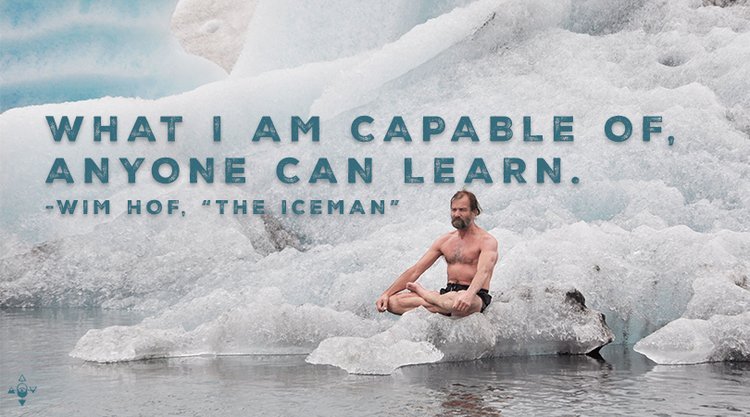The scene baffled scientists for decades. A group of Tibetan Buddhist monks wearing only light robes enter a frigid room, registering barely 40 degrees Fahrenheit on the thermostat. They sit and begin to meditate, seemingly undisturbed by the cold.
Others from the monastery up the ante, taking large towels, soaking them in cold water, and placing them overtop the meditators’ shoulders. If the seated men were like most of us, they would start shaking and shivering violently. But the monks do not move. Suddenly, steam begins to rise from the towels. Within an hour, the towels are dry.
This scene described from a French study in the mid-2000s by the Harvard Gazette, and which has also been observed historically in ceremonies in the Himalayas for the last century, shows the power of Tummo meditation. Tummo is a Tibetan word for “inner fire,” and with the practice, skilled meditators are able to raise their core body temperature by several degrees (up to 17 has been recorded), even in freezing conditions.
The practice takes years or even decades to master. But an athlete known for extreme stunts in frigid temperatures says he’s developed a method that allows people to access benefits similar to those produced by Tummo in just hours. Laboratory studies show that he might be onto something.
The Iceman Cometh
The athlete is Wim Hof, who’s also known as “The Iceman.” He earned the name by performing incredible feats in hostile conditions. He once ran a marathon above the Arctic Circle barefoot, wearing only shorts. He has spent more than an hour packed in ice while scans showed that his body temperature did not decrease. Hof says he’s been able to do all of these things thanks to a combination of breathing techniques and mental focus, some of which he learned through yoga and meditative practices. He says he was introduced to yoga around the time he was 10 years old.
“By 12, I was really getting into Buddhist and Hindu scriptures,” Hof says. “I read all the Sanskrit. And the explanation of yoga I took from it is: Yoga is the silencing of the modifications of the mind. If we are able to control the mind, then the spirit can evolve and expand.”
Hof tested his own mind and spirit in the cold waters of Amsterdam, Netherlands. At age 17, while walking through Beatrixpark (a park located south of the city’s center) on a Sunday morning, he found himself drawn to a partially frozen pond.
“I was just attracted to the cold water with a thin layer of ice,” Hof says. “I just took off my clothes and went in. Surprisingly I didn’t feel the cold at all. I just felt great. That’s because, unconsciously or subconsciously, I was ready to do that.”
Hof says immersion in the cold taught him how to focus, take hold of his mind, and eventually enable him to control elements of his nervous system thought to be strictly involuntary. For example, Hof says—and has studies that appear to prove—he can exhibit control over his immune system. Researchers at Radboud University in 2011 injected Hof with bacteria that should have brought about flu-like symptoms while Hof meditated. No illness occurred.
They later repeated the test on Hof and 12 people to whom he’d taught his breathing and meditation techniques, as well as 12 untrained subjects. Those who practiced Hof’s techniques had far higher releases of epinephrine (also known as adrenaline), a fight-or-flight stress hormone that can improve immune response. The 12 trained subjects exhibited less than half of the symptoms of illness that the untrained subjects displayed.
Recent studies also show that people can influence their own body temperature with far less training than originally thought. Researchers compared the control of two groups of people: One was a set of expert Tummo meditators in the mountains of Tibet, the second a group of 11 people (10 of whom were women) near Maplewood, New Jersey. Group two participants had spent an average of six years practicing yoga or a martial art, but were untrained in Tibetan meditation. This group was given a short crash course in a Tummo breathing technique.
Using thermometers placed in the subject’s armpits, researchers observed that people in both groups were able to elevate their core body temperature by nearly two degrees Celsius. The more experienced meditators were able to maintain the higher temperature for a longer period of time, which scientists credited to their improved ability to focus and visualize the heat. But the relatively untrained subjects experienced a significant temperature increase using only breathing.
Try The Iceman’s Technique
If you’re feeling chilly this winter, or just want to try one of the Iceman’s internal-furnace-igniting techniques yourself, Hof recommends the following breath pattern. Be sure not to practice this underwater (it can be very dangerous) or while operating a vehicle (it may seem like a convenient place for this, however, it is not a good idea).
Take a deep breath, but rather than consciously exhaling and pushing the air out, just sort of “let it go.” Your lungs will naturally expel the excess air and carbon dioxide. Take 10 breaths like this in a row, trying to go a little bit deeper with each successive inhale, but putting no force behind your exhalation. After your 10th breath, take in one more deep breath and this time hold it in. Engage the muscles in your chest, back and shoulders, as if you were using them to give the air inside your lungs a firm hug. You may notice a warm, tingling sensation inside your chest.
Related: The Power of Breath for Physical and Emotional Balance
What’s happening during the hold? According to Hof, you are firing up a good form of fat within your body. Brown fat is a type of tissue within mammals that will emit heat when necessary for survival.
“We have brown fat adipose tissue inside of our chest on the back,” Hof says. “[Brown fat] will be triggered by this breathing technique. It’s a way to influence the energy in the brown fat adipose tissue.”
Hold on to the breath for as long as you feel comfortable, or until you notice a warming sensation in your chest. Then let go with an exhale. You can repeat the 10-breaths-and-hold pattern as many times as you like.
“There is no limit,” Hof says. “It’s only when you feel energy is being released, and everybody has a different physiology. But most of the times, a couple of cycles enables people to release the energy.”
Hof teaches his breathing techniques and other ways to improve one’s resistance to the cold at wimhofmethod.com.








Comments (0)